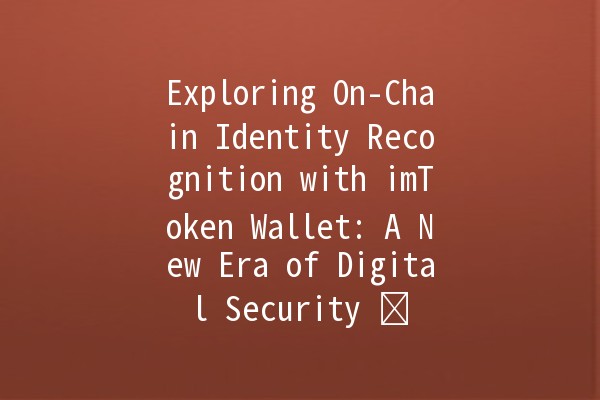In the fastevolving world of blockchain technology and digital assets, security and identity verification are paramount. Onchain identity recognition presents a robust solution, particularly for users of the imToken wallet. This article delves into the significance of onchain identity recognition, its benefits, and how to maximize productivity within this innovative framework.
Onchain identity recognition refers to the process of verifying and validating a user’s identity on a blockchain network. Unlike traditional identity validation methods, which rely on centralized databases and institutions, onchain recognition leverages the decentralized nature of blockchain technology to offer a more secure and transparent solution.
When users engage with blockchain applications, especially in decentralized finance (DeFi) and nonfungible tokens (NFTs), establishing verified identities can help significantly reduce fraud and enhance user trust. With imToken wallet's powerful features, users can navigate the blockchain landscape while enjoying the security that comes with onchain identity recognition.
Onchain identity recognition provides a decentralized method for verifying user identities. This reduces reliance on centralized institutions, minimizing the risk of data breaches or identity theft. For example, if you use an imToken wallet and engage in a transaction, your identity verification occurs onchain, enhancing security at every step.
Users maintain greater control over their personal data. With onchain identity verification, individuals can choose what information to share, putting them in charge of their digital identities. This empowerment leads to more secure interactions in the digital space, particularly in transactions that require trust.

By providing verified identities, users can gain quicker access to various decentralized services, including lending platforms and NFT marketplaces. The reduction in verification time allows users to engage more freely with platforms, improving user experience and satisfaction.
Onchain identities can potentially work across different blockchain ecosystems. This interoperability means a user could easily engage with multiple dApps (decentralized applications) using a single verified onchain identity.
Blockchain's transparency combined with onchain identity recognition helps detect and mitigate fraudulent activities. Users who have their identities verified onchain are less likely to engage in malicious activities, fostering a safer and more trustworthy environment.
Description: MFA adds an additional layer of security by requiring multiple forms of verification before granting access to your account.
Application Example: When setting up your imToken wallet, enable MFA to require a password and a timely verification code sent to your mobile device. This extra step enhances your security, making it difficult for unauthorized users to access your wallet.
Description: Keep your onchain identity up to date. Regular updates ensure that the data associated with your wallet remains accurate.
Application Example: Periodically visit the settings section of your imToken wallet to check and update your personal details, such as contact information or recovery phrases. This ensures that you don't miss critical communications and that the wallet's recovery mechanisms work effectively.
Description: Organizing and securing your private data is essential in maximizing your productivity and keeping your onchain identity safe.
Application Example: Use encrypted digital storage services to save sensitive documents and keep track of your wallet’s private keys. This organized approach not only enhances security but also makes it easier to access necessary information quickly when needed.
Description: Use verified decentralized applications that prioritize security and user identity verification.
Application Example: When interacting with new dApps on the imToken platform, always check for user reviews and verification details. This helps ensure that the service is trustworthy and minimizes the risk associated with sharing your identity.
Description: Staying informed about the latest developments in blockchain security can significantly enhance your ability to navigate onchain identity recognition safely.
Application Example: Regularly read articles and attend webinars on blockchain security practices. Understanding concepts such as phishing attacks, smart contract vulnerabilities, and decentralized identity principles will empower you to manage your wallet and digital identity more effectively.
Q1: What types of identity verification does the imToken wallet support?
The imToken wallet leverages innovative blockchain technology to facilitate various identity verification methods, primarily focusing on decentralized approaches. Users can integrate multiple verification mechanisms, including biometric data and cryptographic key signatures, to ensure their identities are securely confirmed.
Q2: How can onchain identity recognition prevent fraud?
Onchain identity recognition minimizes fraud by providing transparent and verifiable identity data that is immutable once recorded on the blockchain. This transparency deters malicious users from manipulating identity data because changes are publicly accountable, enhancing trust in digital transactions.
Q3: Are there any risks associated with onchain identity recognition?
While onchain identity recognition offers enhanced security, users must remain vigilant against potential risks, such as loss of access to their keys or personal data exposure due to hacks. Adhering to best practices, such as using MFA and keeping sensitive information private, can mitigate these risks.
Q4: Can I use my onchain identity across different platforms?
Yes, one of the primary advantages of onchain identity recognition is the potential for interoperability. Users can utilize their verified identities across multiple decentralized platforms, simplifying access to various online services and enhancing user experience.
Q5: How does imToken ensure user data privacy?
imToken prioritizes user data privacy by using advanced encryption methods and allowing users to control their personal information. By enabling selective disclosure, users can choose which data to share during transactions, ensuring privacy remains intact while still allowing for necessary identity verification.
Q6: What should I do if I suspect unauthorized access to my wallet?
If you suspect unauthorized access, immediately revoke all permissions and associations tied to your imToken wallet. Change your passwords, enable MFA if you haven’t done so already, and consider moving your assets to a new wallet address to ensure they remain secure.
Onchain identity recognition represents a significant advancement in how we secure and manage our digital identities, particularly for users engaging with blockchain technologies like the imToken wallet. By understanding and implementing best practices as highlighted, users can fully leverage the advantages of this innovative system, paving the way for a more secure and trusted digital landscape.